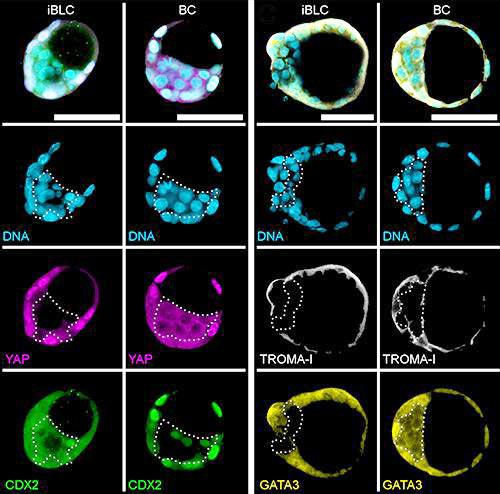Implantable 3D blastocyst-like embryonic structure generated from mouse stem cells

Left 2 columns: Early iBLC and early BC stained for DNA (light blue), YAP (magenta), and CDX2 (green). Scale bars = 50 μm. Nuclear-excluded YAP region is outlined with dotted white line. Right 2 columns) Early iBLC and early BC stained for DNA (light blue), TROMA-I (white), and GATA3 (yellow). Scale bars = 50 μm. Downregulated and nuclear-excluded GATA3 region is outlined with dotted white line. Credit: RIKEN
After an egg is fertilized, it begins to divide and passes through several stages. Cells in the two-cell stage are totipotent–they can become any type of cell. After many more cell divisions, the embryo turns into a blastocyst that is implanted in the womb where it differentiates and grows into a fetus.
A blastocyst is like an almost hollow ball. Inside are pluripotent cells–cells that can become any type of cell in the body, but not the placenta–while the outer shell is made from trophoblasts–cells that eventually form the placenta.
For several years, scientists have been able to convert somatic cells–like skin cells–into pluripotent cells. However, nobody has been able to convert differentiated cells into totipotent cells. In an earlier study conducted at Gladstone, authors Cody Kime and Kiichiro Tomoda were able to convert pluripotent mouse cells from an implanted-like state to a pre-implanted state.
In doing so, they noticed structures that looked like early embryo blastocysts. As Kime explains, “over seven years ago, our reprogramming experiments suggested that we had found a way to increase cell potency beyond pluripotency, which was unlikely and had not been seen before. Instead of discarding what we had found because it was not our primary objective, we decided to find out if it was real.”
In the new report, the team has refined their reprogramming technique to produce embryo-like structures that are more similar to real embryos. According to Kime, “perhaps our most important finding was that natural molecules found in the early mouse embryo can reprogram cultured cells to become surprisingly similar in function to early embryos.” After seven days of conversion treatment, the new process can produce 5-30 floating self-assembled blastocyst-like structures.
When they examined small clusters of cells a few days before they matured into the blastocyst-like structures, they found that the cells contained gene expression for totipotency that are found in two-cell embryos.
A further test comparing the blastocyst-like structures with their precursors showed that cells in the matured structures were bound close together–a hallmark of blastocyst formation and polarization that is the result of a process called compaction. Cells within the precursors resembled embryos at an earlier stage before compaction, which was good evidence that the precursor clusters might include totipotent cells.
Next the group investigated how genetically and functionally similar their blastocyst-like structures were to actual blastocysts. They found that many genes related to the outer/inner cell fates of blastocysts were present in the induced structures, but at lower than natural levels, indicating that the new technique does not perfectly reproduce blastocysts.
Nevertheless, when transplanted to the womb of pseudo-pregnant mice, the blastocyst-like structures often induced changes to the uterus that are necessary for successful blastocyst implantation, including the integration of the maternal blood supply. The implanted structures often grew and produced many types of cells that resembled those naturally found in early developing embryos. Eventually, the embryos were resorbed, and the surrounding tissue showed signs that were similar to instances of natural resorption.
“Totipotency is the highest order of cell potency: one totipotent cell can form the placenta and the body…everything,” says Kime. “If our system can be improved to fully reach that state we will be able to improve basic research in the fields of embryogenesis and fertility, as well as basic and clinical research in regenerative medicine.”
###
Reference:
Kime, et al. (2019) Induced 2C expression and implantation-competent blastocyst-like cysts from primed pluripotent stem cells. Stem Cell Reports. doi:10.1016/j.stemcr.2019.07.011
Media Contact
More Information:
http://dx.doi.org/10.1016/j.stemcr.2019.07.011All latest news from the category: Life Sciences and Chemistry
Articles and reports from the Life Sciences and chemistry area deal with applied and basic research into modern biology, chemistry and human medicine.
Valuable information can be found on a range of life sciences fields including bacteriology, biochemistry, bionics, bioinformatics, biophysics, biotechnology, genetics, geobotany, human biology, marine biology, microbiology, molecular biology, cellular biology, zoology, bioinorganic chemistry, microchemistry and environmental chemistry.
Newest articles
Faster, more energy-efficient way to manufacture an industrially important chemical
Zirconium combined with silicon nitride enhances the conversion of propane — present in natural gas — needed to create in-demand plastic, polypropylene. Polypropylene is a common type of plastic found…

Energy planning in Ghana as a role model for the world
Improving the resilience of energy systems in the Global South. What criteria should we use to better plan for resilient energy systems? How do socio-economic, technical and climate change related…

Artificial blood vessels could improve heart bypass outcomes
Artificial blood vessels could improve heart bypass outcomes. 3D-printed blood vessels, which closely mimic the properties of human veins, could transform the treatment of cardiovascular diseases. Strong, flexible, gel-like tubes…




















